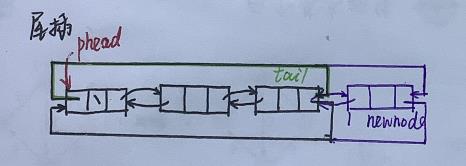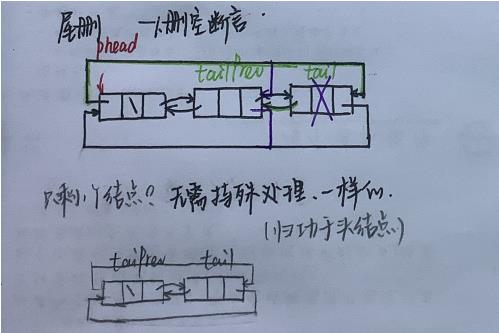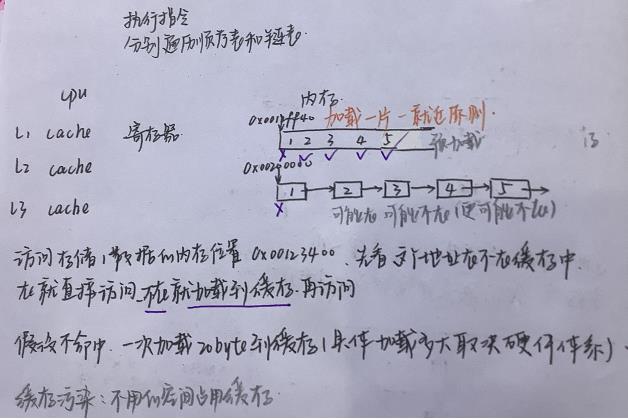带头双向循环链表的实现@线性表
Posted 呀小边同学
tags:
篇首语:本文由小常识网(cha138.com)小编为大家整理,主要介绍了带头双向循环链表的实现@线性表相关的知识,希望对你有一定的参考价值。
目录
🍓本文出现如此多草莓的原因是,我昨天晚上吃了好多草莓,并且现在还想吃。
🍓接下来要更新链表这儿的题解咯~
正文开始@边通书
0. 引
上文提到,带头双向循环链表 ——
- 结构最复杂,一般用在单独存储数据。实际中使用的链表数据结构,都是带头双向循环链表。
- 另外这个结构虽然复杂,却也是无死角的结构,用代码实现时会发现结构会带来很多优势,非常爽,后面我们代码实现了就知道了。

代码实现的简单归功于它复杂的结构,以下这几点都是在写的过程中感受到的 ——
🍓 带头
- 这样使得尾插尾删头插头删不必传二级指针,因为pList这个带哨兵位头节点的地址不会发生改变
- 尾删时,只剩一个节点和普遍情况(>=2个节点)可以合并
🍓 双向
方便找上一个下一个
🍓 循环
使找尾变得简单
1. 双向循环链表实现
1.1 创建、销毁、申请新节点、打印
1.1.1 创建

🍓 对于pList即这个链表地址的分配我们完全可以直接写,但还是推荐写成接口函数
🍓 初始化函数, 对于pList这个实参的改变,我们同样可以采取以往的办法传二级指针(即pList的地址类型,为LTNode**)
🍓 这里采取返回值的办法,返回地址,赋给pList
LTNode* ListInit()
//哨兵位的头结点
LTNode* phead = (LTNode*)malloc(sizeof(LTNode));
if (phead == NULL)
printf("malloc failed\\n");
exit(-1);
phead->prev = phead;
phead->next = phead;
return phead;
test.c中是这样调用的
LTNode* pList = ListInit();
1.1.2 销毁

void ListDestroy(LTNode* phead)
assert(phead);
LTNode* cur = phead->next;
while (cur != phead)
LTNode* curNext = cur->next;
free(cur);
cur = curNext;
free(phead);
//phead = NULL;
注意这里的phead = NULL;很有必要,但这样写没有发挥实际作用(所以我也把它注释掉了),因为phead是形参,形参改变不会影响实参,也就是pList不会改变。
这就导致了野指针的问题 —— 虽然pList仍保持着原来的地址,但是phead已经被释放了,此时pList就是一个野指针。(可以传二级,实际上传二级就不会有这些问题,但为了保持接口一致性用一级比较好)
因此,我们需要在外面,即test.c文件中把它置空 ——
ListDestroy(pList);
pList = NULL;//外面置空,就跟free一样
1.1.3 申请新节点
LTNode* BuyListNode(LTDataType x)
LTNode* newnode = (LTNode*)malloc(sizeof(LTNode));
if (newnode == NULL)
printf("malloc failed\\n");
exit(-1);
newnode->data = x;
newnode->prev = NULL;
newnode->next = NULL;
return newnode;
1.1.4 打印

void ListPrint(LTNode* phead)
assert(phead);
LTNode* cur = phead->next;
while (cur != phead)
printf("%d ", cur->data);
cur = cur->next;
printf("\\n");
1.2 尾插、尾删
1.2.1 尾插

🍓 相比于单链表
-
不必再传二级指针,因为phead不用更改
-
完美处理空链表,无需再把链表为空时的插入单拎出来解决
-
找尾也很方便O(1),不必像单链表一样找尾找得好辛苦
void ListPushBack(LTNode* phead, LTDataType x)
assert(phead);
LTNode* newnode = BuyListNode(x);
LTNode* tail = phead->prev;
tail->next = newnode;
newnode->prev = tail;
newnode->next = phead;
phead->prev = newnode;
1.2.2 尾删

🍓 与单链表相比
-
不必再传二级指针,因为phead不用更改
-
不用单拎出来解决只剩一个节点时的情况,它的结构保证了tail不会为空,就不会被错误的解引用
void ListPopBack(LTNode* phead)
assert(phead);
assert(phead->next != phead);//1.删空了
LTNode* tail = phead->prev;
LTNode* tailPrev = tail->prev;
free(tail);
//链接
phead->prev = tailPrev;
tailPrev->next = phead;
1.3 头插、头删
1.3.1头插

🍓 与单链表相比
- 不必再传二级指针,因为phead不用更改
- 链表为空?也没事。其实这在单链表那儿也没事,就是情不自禁要想一下
void ListPushFront(LTNode* phead, LTDataType x)
assert(phead);
LTNode* newnode = BuyListNode(x);
LTNode* headNext = phead->next;
//链接
phead->next = newnode;
newnode->prev = phead;
newnode->next = headNext;
headNext->prev = newnode;
1.3.2 头删

🍓 与单链表相比
- 不必再传二级指针,因为phead不用更改
- 只剩一个节点?也没事。其实这在单链表那儿也没事,就是情不自禁要想一下
void ListPopFront(LTNode* phead)
assert(phead);
assert(phead->next != phead);//删空时断言
LTNode* next = phead->next;
LTNode* nextNext = next->next;
free(next);
//链接
phead->next = nextNext;
nextNext->prev = phead;
1.4 查找、任意位置插入、任意位置删除
1.4.1 查找
和打印类似
LTNode* ListFind(LTNode* phead, LTDataType x)
assert(phead);
//空链表
if (phead->next == phead)
return NULL;
LTNode* cur = phead->next;
while (cur != phead)
if (cur->data == x)
return cur;
cur = cur->next;
return NULL;
1.4.2 任意位置插入

void ListInsert(LTNode* pos, LTDataType x)
assert(pos);
LTNode* newnode = BuyListNode(x);
LTNode* posPrev = pos->prev;
//链接
posPrev->next = newnode;
newnode->prev = posPrev;
newnode->next = pos;
pos->prev = newnode;
1.4.3 任意位置删除

void ListErase(LTNode* pos)
//按理说应该断言一下pos是pList的情况,但是为了这个再增加一个参数,得不偿失
assert(pos);
LTNode* posPrev = pos->prev;
LTNode* posNext = pos->next;
free(pos);
//链接
posPrev->next = posNext;
posNext->prev = posPrev;
1.4.4 复用
有了上面的任意位置插入删除,就可以快速写出头插头删、尾插尾删。
//尾插
void ListPushBack(LTNode* phead, LTDataType x)
assert(phead);
ListInsert(phead, x);
//尾删
void ListPopBack(LTNode* phead)
assert(phead);
assert(phead->next != phead);//1.删空了
ListErase(phead->prev);
//头插
void ListPushFront(LTNode* phead, LTDataType x)
assert(phead);
LTNode* newnode = BuyListNode(x);
ListInsert(phead->next, x);
//头删
void ListPopFront(LTNode* phead)
assert(phead);
assert(phead->next != phead);//删空时断言
ListErase(phead->next);
2. 顺序表和链表的比较
这两个结构各有优势,很难说谁更优,它们是相辅相成的结构。
| 顺序表 | 链表(带头双向循环链表) | |
|---|---|---|
| 优点 | 1. 支持随机访问,需要随机访问支持的结构可以很好地适用 | 1. 任意位置插入删除效率高O(1) |
| 2. CPU高速缓存命中率高 | 2. 按需申请释放空间 | |
| 缺点 | 1. 头部、中间插入效率低 | 1. 不支持随机访问(即下标访问,如要访问第5个) |
| 2. 连续的物理空间,空间不够了需要增容 | 2. 链表存储一个值,同时要存储两个指针,有一定消耗 | |
| a. 增容有一定程度的消耗 | 3. CPU高速缓存命中率低 | |
| b. 为了避免频繁增容,一般按倍数去增,用不完存在一定空间浪费 |

关于CPU高速缓存命中率,请阅读陈皓的文章与程序员相关的CPU缓存知识 | 酷 壳 - CoolShell,我顺便也读了,没法完全的懂,另外我还被他的其他文章拽走了,太有意思了,但还是解释一下CPU高速缓存命中率。

附:
List.h
#pragma once
#include<stdio.h>
#include<stdlib.h>
#include<assert.h>
typedef int LTDataType;
//带头双向循环---非常棒的结构
typedef struct ListNode
LTDataType data;
struct ListNode* prev;
struct ListNode* next;
LTNode;
//初始化
LTNode* ListInit();
//链表打印
void ListPrint(LTNode* phead);
//销毁
void ListDestroy(LTNode* phead);
//尾插
void ListPushBack(LTNode* phead, LTDataType x);
//尾删
void ListPopBack(LTNode* phead);
//头插
void ListPushFront(LTNode* phead, LTDataType x);
//头删
void ListPopFront(LTNode* phead);
//查找
LTNode* ListFind(LTNode* phead, LTDataType x);
//任意位置插入
void ListInsert(LTNode* pos, LTDataType x);
//任意位置删除
void ListErase(LTNode* pos);
List.c
#define _CRT_SECURE_NO_WARNINGS 1
#include"List.h"
LTNode* BuyListNode(LTDataType x)
LTNode* newnode = (LTNode*)malloc(sizeof(LTNode));
if (newnode == NULL)
printf("malloc failed\\n");
exit(-1);
newnode->data = x;
newnode->prev = NULL;
newnode->next = NULL;
return newnode;
LTNode* ListInit()
//哨兵位的头结点
LTNode* phead = (LTNode*)malloc(sizeof(LTNode));
if (phead == NULL)
printf("malloc failed\\n");
exit(-1);
phead->prev = phead;
phead->next = phead;
return phead;
void ListDestroy(LTNode* phead)
assert(phead);
LTNode* cur = phead->next;
while (cur != phead)
LTNode* curNext = cur->next;
free(cur);
cur = curNext;
free(phead);
//phead = NULL;
void ListPrint(LTNode* phead)
assert(phead);
LTNode* cur = phead->next;
while (cur != phead)
printf("%d ", cur->data);
cur = cur->next;
printf("\\n");
void ListPushBack(LTNode* phead, LTDataType x)
assert(phead);
LTNode* newnode = BuyListNode(x);
LTNode* tail = phead->prev;
//链接
tail->next = newnode;
newnode->prev = tail;
newnode->next = phead;
phead->prev = newnode;
//ListInsert(phead, x);
void ListPopBack(LTNode* phead)
assert(phead);
assert(phead->next != phead);//1.删空了
LTNode* tail = phead->prev;
LTNode* tailPrev = tail->prev;
free(tail);
//链接
phead->prev = tailPrev;
tailPrev->next = phead;
//ListErase(phead->prev);
void ListPushFront(LTNode* phead, LTDataType x)
assert(phead);
LTNode* newnode = BuyListNode(x);
LTNode* headNext = phead->next;
//链接
phead->next = newnode;
newnode->prev = phead;
newnode->next = headNext;
headNext->prev = newnode;
//ListInsert(phead->next, x);
void ListPopFront(LTNode* phead)
assert(phead);
assert(phead->next != phead);//删空时断言
LTNode* next = phead->next;
LTNode* nextNext = next->next;
free(next);
//链接
phead->next = nextNext;
nextNext->prev = phead;
//ListErase(phead->next);
LTNode* ListFind(LTNode* phead, LTDataType x)
assert(phead);
//空链表
if (phead->next == phead)
return NULL;
LTNode* cur = phead->next;
while (cur != phead)
if (cur->data == x)
return cur;
cur = cur->next;
return NULL;
void ListInsert(LTNode* pos, LTDataType x)
assert(pos);
LTNode* newnode = BuyListNode(x);
LTNode* posPrev = pos->prev;
//链接
posPrev->next = newnode;
newnode->prev = posPrev;
newnode->next = pos;
pos->prev = newnode;
void ListErase(LTNode* pos)
//按理说应该断言一下pos是pList的情况,但是为了这个再增加一个参数,得不偿失
assert(pos);
LTNode* posPrev = pos->prev;
LTNode* posNext = pos->next;
free(pos);
//链接
posPrev->next = posNext;
posNext->prev = posPrev;
test.c
#define _CRT_SECURE_NO_WARNINGS 1
#include"List.h"
//测试尾插尾删
void testList1()
LTNode* pList = ListInit();
ListPushBack(pList, 1);
ListPushBack(pList, 2);
ListPushBack(pList, 3);
ListPrint(pList);
ListPopBack(pList);
//ListPopBack(pList);
/*ListPopBack(pList);
ListPopBack(pList);*/
ListPrint(pList);
ListDestroy(pList);
pList = NULL;
//测试头插头删
void testList2()
LTNode* pList = ListInit();
ListPushFront(pList, 1);
ListPushFront(pList, 2);
ListPushFront(pList, 3);
ListPrint(pList);
ListPopFront(pList);
/*ListPopFront(pList);
ListPopFront(pList);
ListPopFront(pList);*/
ListPrint(pList);
ListDestroy(pList);
pList = NULL;
//测试查找、任意位置插入、任意位置插入
void testList3()
LTNode* pList = ListInit();
ListPushBack(pList, 1);
ListPushBack(pList, 2);
ListPushBack(pList, 4);
以上是关于带头双向循环链表的实现@线性表的主要内容,如果未能解决你的问题,请参考以下文章